On the rebound
Coach Craig Robinson, MBA’91, is working to bring back the banner years of Oregon State University basketball.
By Lydialyle Gibson
Photography by Dan Dry
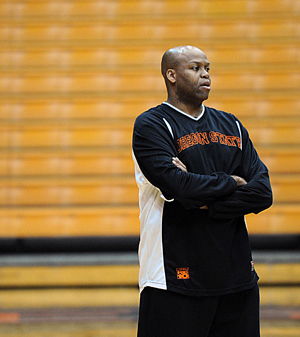
Robinson's most important rule for his players, which he enforces at every practice: "Work hard."
Rolling off a pick at the top of the key, Joe Burton is already halfway to the basket before the ball is in his hands, already spinning upward, head turning, arms out for the pass, already bracing for impact with the defender who’s sliding into his shadow to wait for a whistle and a charging call.
There are 32 seconds left in the game—the second of Oregon State’s conference schedule, against a University of Arizona team they aren’t supposed to beat, a team that’s been at the top of the Pac-10 standings since the preseason poll, while Oregon State fluttered near the bottom through a shaky early season. Last year Oregon State swept Arizona, a staggering double upset that saw the Beavers win in Tucson for the first time in almost three decades. Tonight, their coach warned them, Arizona would be ready. Tonight there’d be no surprising them.
The score has been tied 11 times since the opening tip-off. Now it’s tied again, thanks to an Arizona layup that came easier than it should have.
31 seconds ... 30 ...
Oregon State guard Calvin Haynes dribbles around the backcourt, scanning for open teammates, and as two Arizona players close in, he hurls the pass Burton has been looking for. A shout rises from the home crowd. The players on the bench clamber to their feet, and those on the court stand almost motionless, watching as Burton barrels toward the hole.
29 seconds ...
Coiled in his seat, Oregon State coach Craig Robinson, MBA’91, stands up, hands rising, mouth open. His eyes are locked on Burton, the husky forward he kept calling two years ago after other coaches had stopped, the kid he recruited from the Soboba Indian Reservation, a place tucked into the dusty foothills of California’s San Jacinto Mountains, where gun battles with cops are not unheard of, where drugs and alcohol and gambling have darkened the futures of other promising young athletes. After touring the reservation, Robinson told reporters it reminded him of his childhood on Chicago’s South Side. Burton was the second player to commit to Oregon State after the university hired Robinson in 2008. During his freshman year, Robinson pushed him to trim his weight from 320 pounds to 280, helping Burton become a stronger, quicker player.
28 seconds ...
Leaping off both feet and sailing upward, Burton floats toward the basket as the ball leaves his hands.
If they win this game, the Beavers will open conference play with a 2–0 record for the first time since January 2005. Three nights ago in this same building, Robinson’s team gave Arizona State a thrashing as thorough as it was unexpected—the first win against the Sun Devils in seven meetings. The final score was 80–58, and as the game clock wound to zero, Oregon State’s players bounded off the court to hug their coach.
A former Princeton star forward who walked away from a lucrative career in finance to coach college basketball, Craig Robinson is better known outside Oregon as Michelle Obama’s big brother, the one who introduced her at the Democratic National Convention in 2008, the one who played that famous game of pickup basketball 20 years ago with her then-boyfriend, Barack Obama, to see if he was a guy worth keeping around.
But in Corvallis, Oregon, Robinson is known as “coach.” Arriving three years ago, he inherited a basketball program in despair. From the rafters of Gill Coliseum, bright orange banners recount long-ago Pac-10 championships and NCAA tournament wins. They bear names like Amory “Slats” Gill—who coached the Beavers to the Final Four in 1949 and 1963 and gave the home barn its name—Lester Conner, Steve Johnson, A. C. Green, and Gary Payton, the tenacious point guard who shattered school records for points, field goals, three-pointers, assists, and steals before trash-talking his way through 17 years in the NBA.
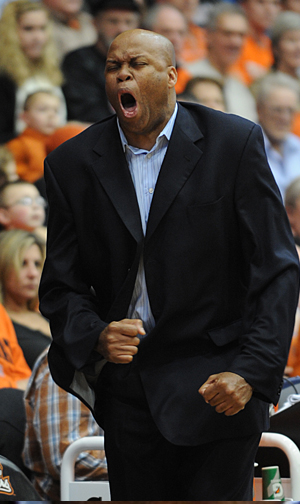
A "no-nonsense" coach, Robinson has brought a modified version of the Princeton offense to Corvallis. He calls it "common sense on the basketball court."
Coach Ralph Miller is in the rafters too, the cantankerous disciplinarian who led the Beavers through 19 mostly glittering seasons. His 1980–81 team, the “Orange Express,” spent eight weeks at number one in the nation and finished the season 26–2. In those days students slept out on the coliseum steps for tickets, and the place was packed with screaming fans night after night.
Miller retired in 1989. Within a few years, everything unraveled. Winning seasons turned into losing seasons, and losing seasons turned into dismal slogs. In January 2008, Oregon State fired coach Jay John—the latest in a string of failed hires—after a loss at the University of Washington, the Beavers’ eighth straight. They didn’t win another game that season. Making Pac-10 history, the team finished 0–18 in the conference. The banners hanging from the ceiling never seemed so far away.
Robinson’s job is to turn all that around, to reverse the years of disappointment and misfortune and humiliation. Three years into it, the work is often slow, and progress uneven: spectacular wins followed by baffling losses, players who shine in one game and in the next seem to disappear altogether. In Robinson’s first year, Oregon State won 13 games—more than twice as many as the year before—but this past season the team seemed to lose ground. Losses piled up in clusters as a younger squad of mostly freshmen and sophomores struggled to translate possessions into points, to maintain leads, to catch up when they fell behind. By mid-February, Robinson was asking for patience. “I owe it to these players and to the university and to all of the people who are true ‘Beaver believers’ to build a program, not a season,” he told the Oregonian. Fan frustration, he said, was premature. “I mean, we’re three seasons away from not winning a game in the Pac-10.”
All but audible behind those words was an expression he learned from his father 30 years ago, when he was a teenager in Chicago’s adolescent leagues: “Not too high, not too low.” No victory or defeat is as intense as it seems. Don’t be sidetracked by either. “You can’t be so happy about winning one game, but you also can’t get down on yourself when you lose,” he says. “That’s what we’ve been talking about the last two years, because we lost more than we won. I tell the guys, ‘Just keep putting your work in and you’ll see the results.’”
Robinson has helped turn programs around before. In 2006, as a first-time head coach, he took over Brown University’s flagging basketball program. That year the team swept Princeton for only the second time in its history, and Robinson was named Ivy League coach of the year. The following season Brown finished second in the conference, earning a postseason berth for the first time in four years.
Before that, in 2000, when Bill Carmody was hired to bring basketball back to life at Northwestern—a team long mired in futility—Robinson came with him as an assistant coach. Between 2001 and 2005, the Wildcats amassed 57 wins, the most ever for the school during a four-year period. Recruiting improved, the rankings inched upward, and Northwestern began to contemplate the postseason.
One thing Robinson’s coaching experience has taught him: “No matter how much you hear about how bad it is,” he says, “it’s always worse. I think I’m really good at managing my expectations, you know, saying, ‘All right, this is going to be really tough.’ And then when you dig in there and you get your hands in the clay, you realize, ah, this is way worse than I expected.” Nowhere has it been truer than at Oregon State.
They couldn't look him in the eye. When Robinson and his coaching staff arrived in Corvallis in April 2008, they found Oregon State’s players so demoralized by loss after loss after loss, “they couldn’t have a discussion with you,” Robinson says. They mumbled, they shuffled, they fell silent. They hardly lifted their eyes from the ground. “And people never saw them on campus,” Robinson says: varsity athletes at a Division I university, absent almost entirely from view. They were as invisible socially as they might have wished to be on the basketball court. “Because they lost every game they played,” Robinson says. “They lost every game they played, at a big-time school like this, where the whole eyes of the community are on football and men’s basketball.”
There were other problems: discipline, work ethic, a lack of trust in each other and the coaches. Losing had taken hold of the players’ psyche and spread like a contagion to every part of their game. Believing themselves to be losers, they lost—they lost contests for rebounds, scrambles for loose balls, races to the basket; they lost fast-break opportunities, open shots, and battles of wills. Losing had become a habit, Robinson says, and “I had to break them out of their habits.” He held practice at 5:30 a.m., “just so they could understand what it’s like to get up and go to work every day. They didn’t have any concept of that.” He made them run; he made them drill; he made them work. And if they didn’t work hard enough, they ran and drilled some more.
“We don’t have a lot of rules,” Robinson says, but players know better than to break those he has. The first rule: be on time. “Which means 15 minutes early,” he says. Then: be in shape. Then: don’t get into trouble. “And if you’re in trouble, I want to be the second—if not the first—to find out about it.”
And finally: work hard. Work as hard as you possibly can.
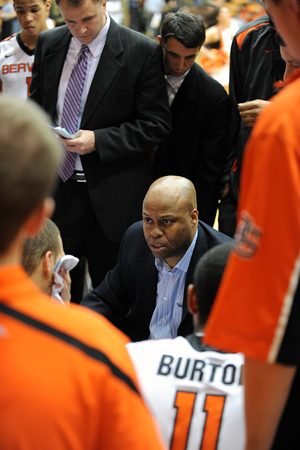
In December, Oregon State beat Arizona State for the first time in seven meetings. Says Robinson: "Everything we do here is, 'We haven't done it since—'"
From the beginning, Robinson held players accountable in front of the group, something he learned from his Princeton coach, the irascible—and successful—Pete Carril. “We call it going down the line,” Robinson says. “They all get evaluated in front of everyone else so that they all know where they stand.” The best player on the court knows not only that he’s the best; he and all his teammates know exactly why. The same goes for the player still keeping the bench warm at the end of the game. “There are no secrets,” Robinson says. Going down the line keeps everybody honest, gives the players a reason to work harder, offers them proof of Robinson’s fairness. “There’s no favoritism here,” he says.
Joe Burton’s stepfather, Kendall Nichols, has come to most practices since the season began. A junior college and Amateur Athletic Union coach, he moved to Corvallis last fall, taking the school year off to live with his son and watch him play. Sometimes Nichols and a couple of other fathers stretch out behind the bench and watch Robinson at work. In half whispers, they discuss the plays, the practice, the players, the coach. “Robinson, he’s honest with the kids; he tells them the truth,” says Nichols, who coached Burton from when he was ten years old through high school. “Most coaches go behind the kids’ backs and tell the kid one thing and tell the other kids something different. No. Whatever he tells you, he tells you in front of the whole team.”
Jeffrey Cunningham, whose son Jared is the team’s starting point guard, flies up from the Bay Area for several home games and practices every season. He calls Robinson a “structured coach and a no-nonsense coach,” someone who doesn’t tell people what they want to hear. “And we felt real comfortable with that.”
Oregon State won seven conference games during Robinson’s first season. Suddenly Gill Coliseum was raucous again. “We had the third-biggest turnaround in NCAA history, with guys who people said couldn’t win a game,” Robinson says. “And see, that was the hard part to stomach. Imagine if your son was one of those kids, and people were saying that about him. That would be heartbreaking.”
Robinson was always the worrier of his family. As a boy, he worried about his sister’s piano recitals, the family’s strained finances, the multiple sclerosis that was slowly destroying his father’s ability to walk. He still worries, about his wife, his children—and his players. “I want them to leave this place with high self-esteem,” he says. “And they put so much into winning and losing that I don’t want to let them down.” He worries about their grades and their problems. He wants them to be better men and better players. Robinson worries so much about them that he doesn’t eat before games. “I can’t,” he says. “My stomach.” During the team meal four hours before the Arizona game, he sits with a glass of water on the table in front of him, his smile tight, his elbows perched on his knees like someone poised to spring, chatting with the players and assistant coaches as they devour platefuls of spaghetti, rice, potatoes, salad, and fruit.
Although the team made a quick turnaround under Robinson, the first victory didn’t come right away. It was the fifth game of the season, on the road against a nonconference opponent, Fresno State. Trailing in the second half, Oregon State pulled away late to win 62–54, snapping a losing streak that stretched back to December 2007. After the game, the locker room was chaos. “You would have thought we had won the world championship,” Robinson says. “They were just so happy to have won a game.”
He might have expected their first win in almost a year to come at Gill, in front of their own fans. It’s always harder to play on someone else’s hardwood. “Unless,” Robinson says, “you’re afraid to play at home. When you lose all the time, the pressure is at home.”
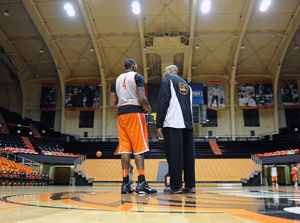
After Fresno State, the team picked up a couple of wins in Corvallis, and then a couple more. With each successive victory that season, the gloom lifted a little. Then in late January 2009, they traveled to Berkeley to play the University of California in a game on which their whole hearts were riding, a game that was more momentous than any stat sheet would ever show. A game against their former coach.
Jay John, fired from Oregon State the previous year, was now an assistant coach at Cal. By the end of his six-year tenure in Corvallis, the disconnect between coach and players had become obvious. The Oregonian was writing about how he’d lost control of the team, how the players no longer listened to him, how they no longer believed in him. When he resurfaced at Cal, some Oregon State players literally circled that game on their calendars. “So,” Robinson says, “there was some extra emotion.”
And extra distraction. The game fell on the Thursday after Barack Obama’s inauguration, an event for which Robinson flew to Washington just as his team began gearing up. They practiced Tuesday without him, and the following day he met them at the Oakland airport. That night they practiced at a high-school gym. A constant commotion engulfed them. “All people could talk about was the inauguration and the election of Barack Obama,” Robinson says. “There were news crews following us around outside practice. It was crazy for the guys. All I could think was, I hope we don’t get blown out.”
He did his best to keep the atmosphere normal. He ran his players through their usual drills, stuck to the usual routines. The night of the game, Robinson emerged from the locker room, as he usually does, at about three minutes before tip-off; his team was warming up and waiting for him by the bench. But as he crossed the court, the crowd rose in a standing ovation. It took Robinson a few seconds to realize what was happening, that this gesture was for him, that the opposing fans were cheering Barack Obama’s brother-in-law. He’s not sure how long the moment lasted; it seemed to go on and on. “So I get a lump in my throat,” he recalls. “I’m getting choked up. ... I have to fight this back, because I’m already worked up because the guys want to do well against their old coach.”
And they did. Behind by seven at halftime, Oregon State came back to win by four points. Afterward the locker room erupted in tears, shouts, and hugs. Players jumped into each other’s arms and danced. “One guy is up on the lockers, he’s so excited,” Robinson says. “He’s laying on top of the lockers, yelling and screaming.”
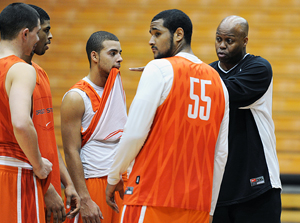
In the midst of this jubilation, one of Oregon State’s seniors walked over to the board and wrote, “It ain’t over.” Meaning: they had another game in two days and more the following week, and in the weeks and months after that. Not too high, not too low. “I could have seen them taking that game and then not winning another game,” Robinson says, “because that’s all they needed.”
But it wasn’t all they needed. Two nights later, Oregon State clobbered Stanford by 15 points. The win seemed to validate the Cal game. “So now the kids are starting to believe in what we’re doing,” Robinson says. “Now this is starting to feel real.”
After the regular season ended, the Beavers plowed through the third-tier College Basketball Invitational (CBI). Not exactly the NCAA tournament, or even the NIT, but that hardly mattered: for the first time in forever, the Beavers were still playing at the end of March. On April 3 they beat UTEP in Corvallis before a sell-out crowd to take the championship. A photograph from that night shows a throng of Oregon State players—young men who 12 months earlier had trouble meeting their coach’s gaze—clutching a crystal trophy, holding triumphant fingers in the air.
Even before practice starts the day after the Beavers blew out Arizona State, even before Robinson steps into the gym and sees his players casually tossing up shots, sees them chatting as rebounds fly off the backboard, he knows that he will have to be impossible. Arizona will be here in two days, with strong post players, good three-point shooters, and the confidence that comes with a 12–2 record. After the previous night’s triumph at Gill, Robinson’s players will need to be reminded that one win doesn’t guarantee another, that games get harder—not easier—as the season progresses. “Our guys are in the locker room thinking they’re going to be 2 and 0 in the conference just by showing up,” he says before practice, “so I’m going to make today just a little bit stressful for them.”
As practice grinds on, the players begin to wonder—though they dare not ask—when it will end. Looming at midcourt, his jaw set and his arms crossed, he watches them run through their zone defense again and again during furious, 30-second scrimmages meant to simulate Arizona’s half-court offense. The players keep missing their spots, failing to block out, losing control of rebounds. They’re perpetually half a step behind. Robinson cajoles them, berates them, flings sarcastic rebukes that are sometimes funny but never mirthful. The players absorb his lashes in silence. “You need a blow?” he challenges one forward caught flat-footed while an opposing player speeds past. “You tired? Your legs hurt? Then WORK HARDER!”
Some of Robinson’s exasperation is for show—after all, he planned for a difficult day—but the longer practice wears on, the more real it gets. At one point he halts the play and says, “Maybe I’m being too quiet. Is that what it is? You need me to make a spectacle of myself? All right then, let’s go!” Then he’s everywhere, rushing at his players as they rotate the ball from one corner to the other. “Move!” he shouts. “Block out! Go!” After the play, he’s all over them: “Who’d you block out? Who’d you block out?”
At 10:30 p.m., he sends his players home, after three-and-a-half hours of practice. It’s New Year’s Eve. He tells them to be back at 10 the next morning for an extra practice—there’s already one planned for 6 p.m. “We’re lucky we have an extra day to work,” he says as they file into the locker room.
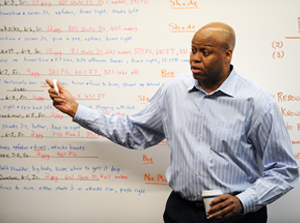
Looking back, it’s hard to see how Robinson could have become anything but a coach. This is the boy who fell in love with basketball at ten years old, shooting hoops alone on the court outside his family’s cabin during a summer vacation in the Michigan woods. In his book A Game of Character (Gotham Books, 2010)—as much basketball diary as autobiography—he describes the syncopation of the bouncing ball and the squeak of his sneakers and his heartbeat and his breathing: “an improvisation that I could control and change up all on my own.” After breakfast he and his father would sometimes play until dark, Robinson leaping and flitting while his father, a former boxer and swimmer, chased him up and down the court despite his increasing limp.
Other important coaches followed: Johnnie Gage, the tough-loving young leader of the West Side team Robinson played for as a teenager; Father Mike, a sweatsuit-clad priest at Mount Carmel Catholic High School; and Pete Carril, who recruited Robinson to the Ivy League and schooled him in his famous Princeton offense, a modified version of which Robinson adapted at Oregon State. “It’s really just a philosophy of passing and cutting,” he says. “It’s common sense on the basketball court. And not only is it common sense, it’s the natural flow of the game—how the game should be played. If you’re not open, you should pass it, and if you’re open, you should shoot it, and if you shoot it, it should go in.”
His senior season at Princeton, Robinson was named Ivy League Player of the Year, and afterward he was drafted, then cut, by the Philadelphia 76ers. He played professionally in England for two years, returning home in 1985 in search of a new career. Already he loved coaching—he’d done some during college summers, and overseas he’d helped teach his teammates a few Princeton offense basics. In the States he went to see Carril, to hear what his old coach had to say about the job. Carril’s answer: “dead-end, no-win, thankless.” You don’t want to be a coach, Carril told him.
So Robinson turned to finance. He had friends from Princeton who were stockbrokers and investment bankers, who owned their own financial firms. He decided to join them. For 15 years he worked at Morgan Stanley and at a smaller, minority-owned investment company he joined as a partner and managing director.
He got married and went to business school at night, earning a Chicago MBA in 1991. He had two children—a boy, Avery, and a girl, Leslie, both gifted athletes in their own right. He made more money than the son of a city water plant swing-shift worker and a catalog-store secretary ever imagined possible. But he wasn’t happy. His marriage was falling apart, and coaching still called him. His most rewarding hours were spent off-hours, working as a coach: at the YMCA, the Lab Schools, the Illinois Institute of Technology. So when the call came from former Princeton assistant coach Bill Carmody, newly hired at Northwestern, offering Robinson an assistant coaching job, he grabbed it.
Ask Robinson about coaching, and he’ll tell you about his players, the kids who trust him with their hopes and ambitions, their problems and insecurities, their lives. Kids who come over for dinner with him and his second wife, Kelly, and their son, Austin, born last January. Kids like Burton, who, after every made free throw, solemnly spreads the fingers of one hand above his forehead to represent “feathers for the Native people,” a sign of reverence and thanks for his heritage. Kids like redshirt freshman Roberto Nelson, whose father—and former coach—is serving seven years in prison, whose life has been full of upheaval. “When I was at Brown, I was dealing with kids who were starting on third base,” Robinson says. “If you’re at Brown, you’ve got it figured out. All I can do is augment what you’re getting from somewhere else. Kids here—I mean, we’ve got a couple kids on the team who were not ready for college. Those are the kids I think I can help the best. And that’s why this job was attractive to me.”
Oregon State’s four seniors were freshmen when Robinson arrived. “They’ve been through a lot,” he says. And they’ve grown. Left-handed guard Calvin Haynes used to have “zero respect for his academics.” Sometimes bad grades kept him out of games. “He would come to practice, and I wouldn’t say anything to him but, ‘Go to class.’ It’s a big joke now.” He’ll graduate this spring. Once a “me-oriented” player, Robinson says, Haynes spent the past two seasons helping the Beavers’ incoming guards improve their game, even though it cost him playing time. Guard Lathen Wallace, meanwhile, was a “very surly kid” when Robinson arrived. “He was mad at the whole world, and he had a real anger problem. He is now by far our hardest worker.”
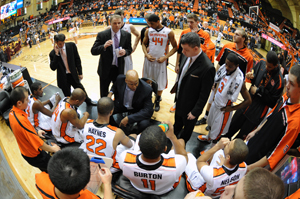
Forty-five minutes before the tip-off against Arizona, the players gather in their basement locker room at Gill and wait for Robinson to emerge from the tiny, window-walled office where his suit jacket lies folded on the desk. At last he opens the door and strides over to a whiteboard covered with diagrammed plays, opposing players’ stats, and ingrained commands: “Move feet,” “Cut hard!” “Rebound and go,” “No turnovers.” Calmly, reassuringly, he talks for 15 minutes about which of Arizona’s players is greedy or rough or unafraid to shoot in transition. He reminds them to block out, to set screens, not to be fooled by ball fakes. He tells them that tonight they’ll have to bring their best game. “Play hard. Run around hard—make them afraid of you,” he says. “Because right now, they think they’re going to win. They don’t know we’re going to kick their asses.” Then, clapping, the players jump to their feet, shout “Team!” in unison, and head out into the corridor, where they clasp hands for a whispered prayer. Omari Johnson, a long, lanky senior, puts his arm around injured freshman Eric Moreland, whose shoulder is in a sling. Basketballs from Arizona’s warm-ups thunder above as they bow their heads. Two minutes later they’re bounding up a concrete stairway, past the sign that reads “Our House” in block letters, past the shouts of “Let’s go, Beavs!” from athletic department staff, and out onto the court, where the waiting crowd cheers.
The game is close. With 32 seconds to go, Burton sets his pick, rolls to the basket, and makes the layup to put Oregon State ahead by two. At the other end of the court, Arizona misses a shot and, out of options, is forced to foul. Haynes sinks two free throws and then two more. The final buzzer sounds. “A complete toughness win,” Robinson tells reporters during the postgame press conference.
After the Arizona game, Oregon State’s season took a rough turn. The team lost ten of its next 12 games. Some were close, many were not. Often the Beavers fell behind early and simply couldn’t catch up. In some ways, this season is reminiscent of the one that followed the 2009 CBI championship. The Beavers won eight conference games that year—one more than the previous year—but it didn’t feel like it because they took losses they shouldn’t have and were eliminated in the first round of the 2010 CBI tournament. The whole season felt rockier, more arduous. “When you’re rebuilding a program,” Robinson says, “you have to take all the right steps; otherwise you end up having to start over again.”
That’s what he found himself explaining to the Oregonian in February: building a program is harder than building a team. “This is kind of blasphemous for a coach to say,” he says, “but when you’re trying to teach kids how to grow, you’ve got to take some steps backwards before you can go forward.” Oregon State is still taking its lumps for a better program. “For us, a loss isn’t yet an anomaly. A loss is potentially slipping off the wagon.” He wants to compete for the Pac-10 championship every year, going deep in the NCAA tournament, reaching a point where no single win is so momentous, and neither is any single loss. Not too high, not too low. It ain’t over yet.